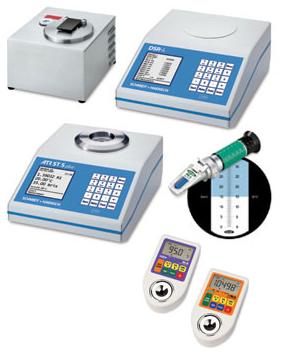Refractometers measure the refraction of a beam of light in a fluid to determine the concentration of a substance dissolved in it.
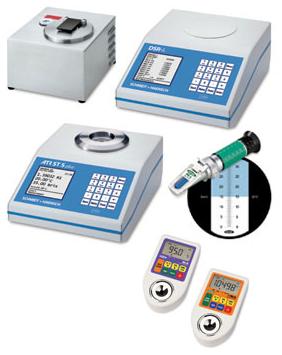
General Information
Refractometers are used to measure the refractive index of a pure substance or mixture. Every substance has a unique refractive index that can be determined accurately. Refractive indices vary with composition as well as wavelengths of light, and are usually noted along with their respective wavelengths.
A refractometer can also measure the “percent solid”, the concentration of a solid substance in water or other fluids. Light slows down or speeds up as it enters a fluid, depending on the density of the sample. By sending light through a fluid sample, a refractometer can be used to determine the speed of this refracted light and report it using various scales .

Equipment Design
Available refractometer styles include, from left to right, digital, handheld, and bench top, not shown to scale. Handheld and digital equipment are both used for field study. A digital refractometer can be brought in contact with a fluid and display a readout, whereas a handheld refractometer must be brought to the eye to read.
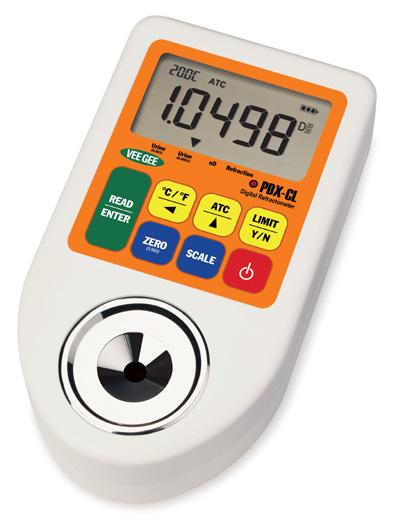
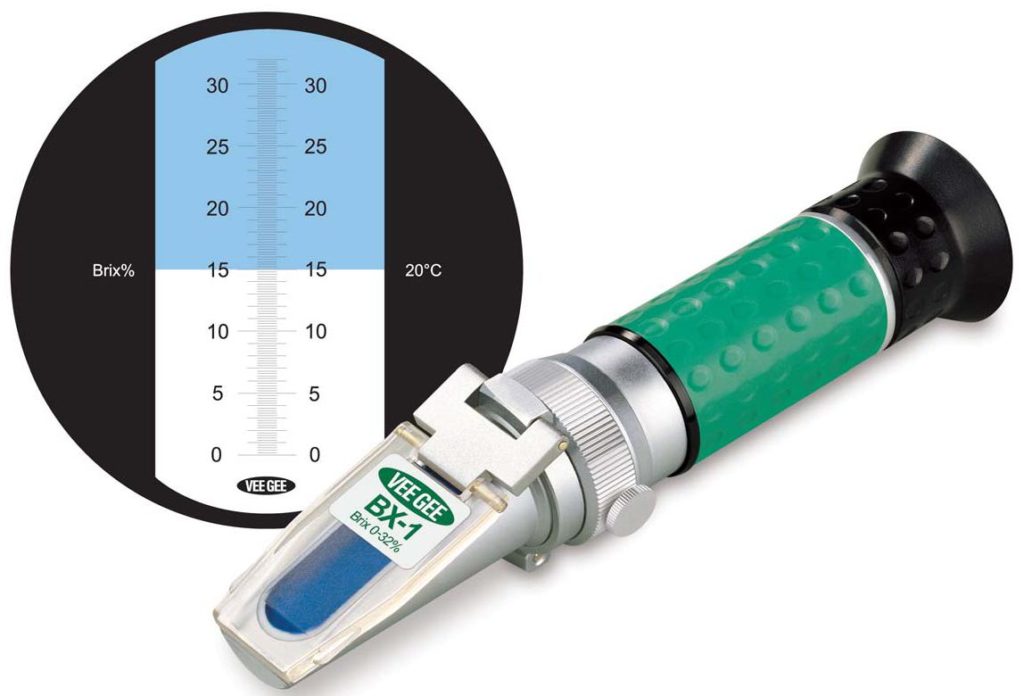

(Copyright VEE GEE Scientific, Inc., Kirkland, WA)
Digital refractometers just require 2-3 drops of the sample placed on the prism to determine and display results. Traditional handhelds require the user to look through the eyepiece to see results on the scale. These methods are shown below.

(Copyright Essex Scientific Laboratory Supplies, Essex, UK)

(Copyright Essex Scientific Laboratory Supplies, Essex, UK)
Refractometer measurements are commonly made using the Pulfrich or ABBE refractometer design.
Shown below is an animation of a Pulfrich refractometer. First, a sample of the test fluid (purple) is put on the face of a glass prism (gray) of a known refractive index. A small beam of light (red) is shined at the prism surface. The resulting beam of light travels through the prism and out the other side. The angle made between the light and the prism is the critical angle. By looking through an eyepiece (dark gray) an observer can measure this critical angle. The refractive index of a sample can be found by implementing this angle into Snell’s Law.
An example of an ABBE refractometer is shown below. On an ABBE refractometer, a sample of a liquid is placed between two similar glass prisms. A beam of light bounces off a mirror at the base of the refractometer and enters the bottom of the optical system of the refractometer.
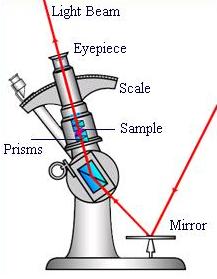
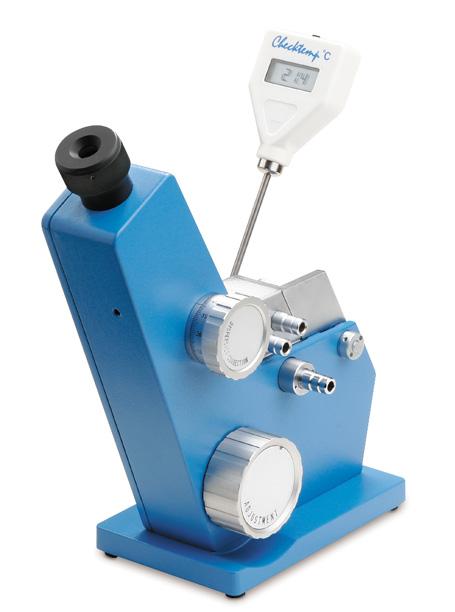
Striking the bottom of the prisms, the entire reflection at the interface can be observed through a movable eyepiece at the top of the refractometer. Once the beam of light is visible through the eyepiece, the critical angle can be read off the scale. Once again, the refractive index of a sample can be found by implementing this angle into Snell’s Law.
Usage Examples
Brix refractometers measure the concentration of sucrose in water and are used for many sugar-related applications. They are used for fruit and juice quality analysis, beverage and food processing and packing, and chemical processing. They can also be used in fields unrelated to sugar, such as industrial fluids. The refractometer shown below is measuring the percent sugar in a variety of samples and can measure from Brix 0.0 to 85.0%.
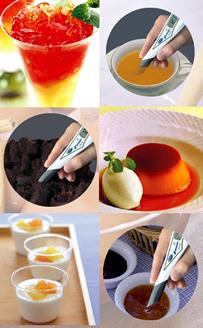
Salinity refractometers and saltwater refractometers measure the refractive index and the amount of totally dissolved salt in aqueous solutions. Used in oceanography and seawater studies, these refractometers are used to determine soil quantity, and check and maintain stock solutions and dilutions. Salinity refractometers are used in the manufacture of frozen vegetables and processing of ocean by-products and saltwater refractometers are found in wildlife management. The salinity meter below is used in the food industry to measure the percentage of salt in condiments such as soy sauce, ketchup, mayonnaise, and Worcester sauce.
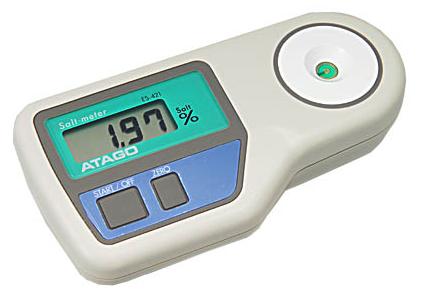
Clinical refractometers, or TS Meters, are found in many hospitals and clinics. Doctors can use refractometers in critical situations to monitor the protein level in plasma and serum. Clinical refractometers also measure the refractive index of a sample, the urine specific gravity, and the percent solid in aqueous solutions. The refractometer pictured below is used to determine acceptable hydration levels of wrestlers by measuring the specific gravity of the athlete’s urine.
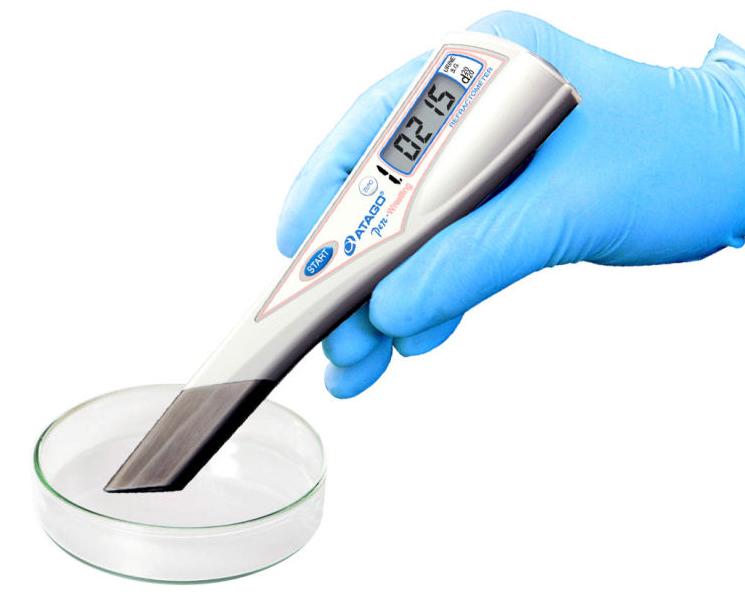
Veterinary refractometers are a type of clinical refractometers used only by veterinarians. They also measure refractive indices and provide a quick way to check vital fluid levels in animals. Veterinary refractometers are used to check for dehydration, protein deficiency, and excessive fluid intake.
Antifreeze/battery testers measure the concentration of coolants. This refractometer tests engine coolant and its freezing point, glycol concentration, and battery charge condition. An industrial fluid tester also measures the concentration of coolants/ lubricants, as well as heat-treating and hydraulic fluids. Used in conjunction with heavy cutting machinery, these refractometers help operators monitor coolant concentration closely to prevent loss of precision and shorter tool and die life.
Advantages
- Most refractometers can be programmed to calculate measurements with up to 5 different scales.
- ABBE refractometers can interface with computers, printers, and data processing equipment, to further analyze readings.
Disadvantages
- Difficult to analyze materials with lower refractive index than that of the prism.
- One must bring a possibly hazardous material close to the eyes to read hand held refractometers.
Acknowledgements
- Essex Scientific Laboratory Supplies, Essex, UK
- MISCO Refractometer, Cleveland, OH
- National Microscope Exchange, Inc., Carnation, WA
- VEE GEE Scientific, Inc., Kirkland, WA
References
- Chilton Company. “Refractometers Measure Jam/Jelly Brix During Cooking.” Food Engineering 67 (1995): 30. Print.
- Considine, P. E., Douglas M., and Glenn D. Considine. “Refractometers.” Van Nostrand’s Scientific Encyclopedia . 8th ed. 1995. Print.
- Hanning, Anders, and Johan Roeraade. “A Spectroscopic Refractometer for Temperature-Independent Refractive Index Detection.” Analytical Chemistry 69 (1997): 1496-1503. Print.
- Sprow, Eugene E. and Production Lines Staff “Refraction Test Refines Wandering Coolant.” Manufacturing Engineering 114 (1995):70-72. Print.
- Podoleanu, A. Gh., S. R. Taplin, D. J. Webb, and D. A. Jackson. “Channeled Spectrum Liquid Refractometer.” Review of Scientific Instruments 64 (1993): 3028-3029. Print.
- Warenghem, M., and J. M. Lefebvre. “Double Arm Pulfrich Refractometer: Application to the Optical Characterization of Biaxially Stretched Polystyrene.” Polymer Engineering & Science 33 (1993): 1360-1365. Print.
Developers
- Jonathan West
- Steve Wesorick
- Kelsey Kaplan

